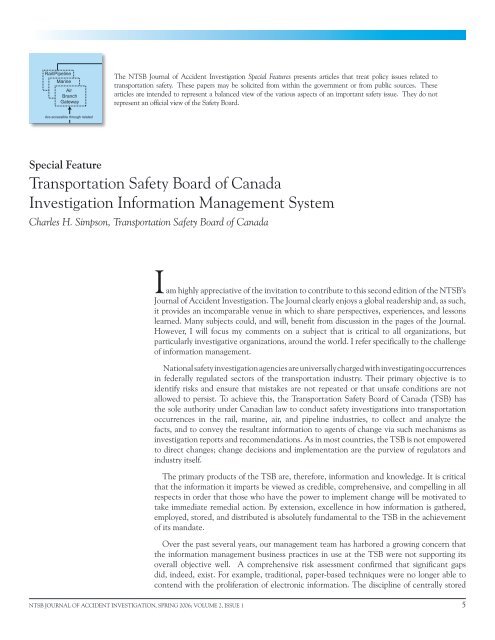Journal of Accident Investigation
Journal of Accident Investigation
Journal of Accident Investigation
Create successful ePaper yourself
Turn your PDF publications into a flip-book with our unique Google optimized e-Paper software.
TIMMS<br />
Navigation<br />
Structure<br />
Rail/Pipeline<br />
Marine<br />
Air<br />
Branch<br />
Gateway<br />
Rail<br />
Pipeline<br />
Marine<br />
Air<br />
<strong>Investigation</strong><br />
Workspace<br />
Special Feature<br />
<strong>Investigation</strong><br />
Services<br />
Gateway<br />
The NTSB <strong>Investigation</strong> <strong>Journal</strong> <strong>of</strong> <strong>Accident</strong> <strong>Investigation</strong> Special Features presents articles that treat policy issues related to<br />
Services<br />
transportation safety. These papers Gateways<br />
Gateway<br />
may be solicited from within the government or from public sources. These<br />
Provide a point to aggregate<br />
articles are intended to represent Information a balanced across many view <strong>of</strong> the various aspects <strong>of</strong> an important safety issue. They do not<br />
workspaces<br />
represent an <strong>of</strong>ficial view <strong>of</strong> the Safety Board.<br />
Workspaces<br />
Central area (or website) for<br />
collaboration on a specific<br />
investigation where all information<br />
related to an investigation is<br />
collected and exchanged<br />
Are associated to every<br />
Transportation Safety Board Workbenches <strong>of</strong> Canada<br />
Data<br />
Tabs with the <strong>Investigation</strong><br />
Safety<br />
Report<br />
Workspace where specialized tools<br />
Analysis<br />
Workload<br />
<strong>Investigation</strong> Production Information Management Management and information required for specific System<br />
Collection<br />
Workbench<br />
Are accessible through related<br />
Workbench<br />
Workbench<br />
TSB<br />
Gateway<br />
Are accessible through<br />
Corporate<br />
Services<br />
Gateway<br />
sets <strong>of</strong> activities related to an<br />
investigation are organized<br />
Charles H. Simpson, Transportation Safety Board <strong>of</strong> Canada<br />
NTSB JOURNAL OF ACCIDENT INVESTIGATION, SPRING 2006; VOLUME 2, ISSUE 1<br />
Governance<br />
Gateway<br />
I am highly appreciative <strong>of</strong> the invitation to contribute to this second edition <strong>of</strong> the NTSB’s<br />
<strong>Journal</strong> <strong>of</strong> <strong>Accident</strong> <strong>Investigation</strong>. The <strong>Journal</strong> clearly enjoys a global readership and, as such,<br />
it provides an incomparable venue in which to share perspectives, experiences, and lessons<br />
learned. Many subjects could, and will, benefit from discussion in the pages <strong>of</strong> the <strong>Journal</strong>.<br />
However, I will focus my comments on a subject that is critical to all organizations, but<br />
particularly investigative organizations, around the world. I refer specifically to the challenge<br />
<strong>of</strong> information management.<br />
National safety investigation agencies are universally charged with investigating occurrences<br />
in federally regulated sectors <strong>of</strong> the transportation industry. Their primary objective is to<br />
identify risks and ensure that mistakes are not repeated or that unsafe conditions are not<br />
allowed to persist. To achieve this, the Transportation Safety Board <strong>of</strong> Canada (TSB) has<br />
the sole authority under Canadian law to conduct safety investigations into transportation<br />
occurrences in the rail, marine, air, and pipeline industries, to collect and analyze the<br />
facts, and to convey the resultant information to agents <strong>of</strong> change via such mechanisms as<br />
investigation reports and recommendations. As in most countries, the TSB is not empowered<br />
to direct changes; change decisions and implementation are the purview <strong>of</strong> regulators and<br />
industry itself.<br />
The primary products <strong>of</strong> the TSB are, therefore, information and knowledge. It is critical<br />
that the information it imparts be viewed as credible, comprehensive, and compelling in all<br />
respects in order that those who have the power to implement change will be motivated to<br />
take immediate remedial action. By extension, excellence in how information is gathered,<br />
employed, stored, and distributed is absolutely fundamental to the TSB in the achievement<br />
<strong>of</strong> its mandate.<br />
Over the past several years, our management team has harbored a growing concern that<br />
the information management business practices in use at the TSB were not supporting its<br />
overall objective well. A comprehensive risk assessment confirmed that significant gaps<br />
did, indeed, exist. For example, traditional, paper-based techniques were no longer able to<br />
contend with the proliferation <strong>of</strong> electronic information. The discipline <strong>of</strong> centrally stored
















